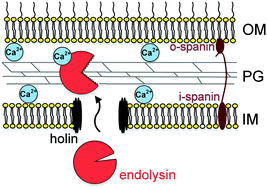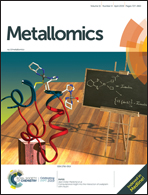Investigation of the calcium-induced activation of the bacteriophage T5 peptidoglycan hydrolase promoting host cell lysis†
Abstract
Peptidoglycan hydrolase of bacteriophage T5 (EndoT5) is a Ca2+-dependent L-alanyl-D-glutamate peptidase, although the mode of Ca2+ binding and its physiological significance remain obscure. Site-directed mutagenesis was used to elucidate the role of the polar amino acids of the mobile loop of EndoT5 (111–130) in Ca2+ binding. The mutant proteins were purified to electrophoretic homogeneity, the overall structures were characterized by circular dichroism, and the calcium dissociation constants were determined via NMR spectroscopy. The data suggest that polar amino acids D113, N115, and S117 of EndoT5 are involved in the coordination of calcium ions by forming the core of the EF-like Ca2+-binding loop while the charged residues D122 and E123 of EndoT5 contribute to maintaining the loop net charge density. The results suggest that Ca2+ binding to the EndoT5 molecule could be essential for the stabilization of the long mobile loop in the catalytically active “open” conformation. The possible mechanism of Ca2+ regulation of EndoT5 activity during bacteriophage T5's life cycle through the Ca2+ concentration difference between the cytoplasm and the periplasm of the host bacteria cell has been discussed. The study reveals valuable insight into the role of calcium in the regulation of phage-induced bacterial lysis.

- This article is part of the themed collection: Metallomics Recent HOT articles


 Please wait while we load your content...
Please wait while we load your content...